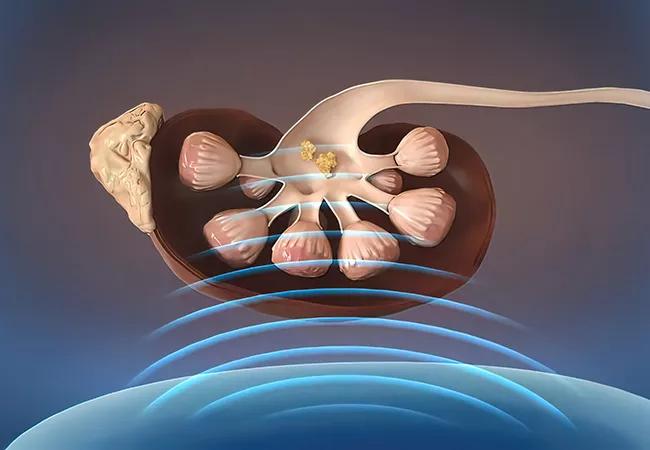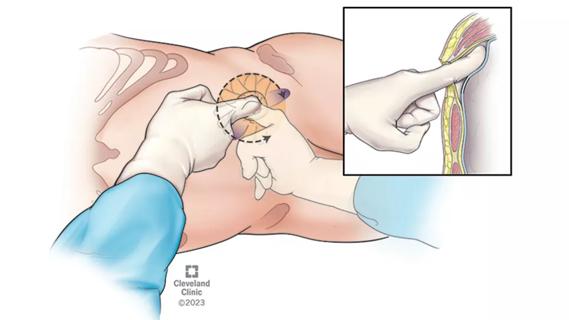Cleveland Clinic is the first to investigate photonic nanoparticles as a potential kidney stone treatment

An innovative approach to fragmenting kidney stones using photonic nanoparticles is effective for several common types of stones. That is the major finding of a proof-of-concept study by Cleveland Clinic researchers published in Nano Letters.
Advertisement
Cleveland Clinic is a non-profit academic medical center. Advertising on our site helps support our mission. We do not endorse non-Cleveland Clinic products or services. Policy
Kidney stones affect nearly 1 in 10 people in the United States and the prevalence is expected to increase to 13% by 2030. They are associated with morbidity and sometimes mortality and can be difficult to treat. The most common treatments are ureteroscopy with laser lithotripsy and extracorporeal shock wave lithotripsy; if those treatments aren’t feasible, more invasive procedures (like percutaneous nephrolithotomy) are an option. Recent studies using more sensitive scans report that often only 60% of patients have no stones following treatment; the residual stones can cause complications and require repeat procedures to remove them.
“There’s a lot of room for improvement in treating kidney stones. In complex cases, it can be difficult to access the stones and some patients aren’t good candidates for the more common treatment options,” says endourologist and co-author Smita De, MD, PhD.
Nanoparticles have been used in various medical applications, including drug delivery in chemotherapy and the COVID-19 vaccine. Vijay Krishna, PhD, Assistant Staff in Lerner Research Institute’s Department of Biomedical Engineering, developed photonic nanoparticles for cancer treatment, but had not yet expanded this approach to hard materials like kidney stones.
Dr. Krishna, senior author on the paper, and Ian Houlihan, PhD, a postdoctoral fellow in his lab and first author, teamed up with Dr. De for the proof-of-concept demonstration of photonic nanoparticles as a viable treatment option.
“We can potentially break up these stones from a distance through using photonic nanoparticles that are activated with deep-tissue penetrating, low-intensity lasers,” says Dr. Krishna. “It’s an unexplored area of photonic nanoparticle technology, but one with major potential for patient care.”
Advertisement
Using human kidney stones obtained from the Cleveland Clinic Pathology Laboratory, the research team experimented with different carbon- and gold-based nanomaterials, as well as laser settings, wavelengths, and distances. They coated the kidney stones with nanoparticles and activated the nanoparticles with low-intensity near-infrared lasers from a distance. In comparison, current laser lithotripsy uses high-intensity lasers that must touch the stones to be effective.
The technique they developed, photonic lithotripsy, was effective across all nanoparticles in breaking down common stone types including calcium oxalate dihydrate, calcium phosphate, uric acid, and the hardiest type, calcium oxalate monohydrate, using lasers ranging from 2-4 W at 1-2 cm.
The project is an example of how potential clinical translation guides biomedical research. Researchers needed to choose nanoparticles that can be modified with binding ligandsto effectively coat the stones, Dr. Houlihan says. Understanding each step of how the coating would reach the stones and how energy would transfer from the nanoparticles to the stone was critical for safety and effectiveness.
“Designing these coatings significantly advanced our clinical understanding of the chain of energy transfer that causes these stones to break apart,” Dr. Houlihan says.
“We developed a protocol that could analyze a signal kidney stone through a number of characterization techniques. Understanding this fundamental mechanism is pivotal to refining this technology, and ultimately applying it to a clinical setting for kidney stones and other hard tissue diseases.”
Advertisement
As a non-contact, low-intensity treatment, photonic lithotripsy has the potential to reduce procedure time and complexity, minimize risk of injury to tissues, improve surgeon ergonomics, increase surgical success rates, and decrease the need for radiation.
“We are very pleased at how well this technique works with different types of stones and nanoparticles. It changes how we think about kidney stone treatment,” says Dr. De. "It could be an alternative for patients who don’t succeed with current techniques or can’t have them."
The research team is continuing its work on photonic lithotripsy to better understand the mechanism of stone breakdown and refine the process. They are also planning animal studies to evaluate the technique’s safety and efficacy.
“The research is at an early stage but based on our findings so far, the prospects are good that photonic lithotripsy could become a safe and effective kidney stone treatment,” says Dr. De.
Advertisement
Advertisement

First single-port renal vein transposition reduces recovery time and improves outcomes

Consider each patient's unique disease progression and treatment goals when choosing a strategy

More than 30% of patients die when early dialysis is needed after surgery

First full characterization of kidney microbiome unlocks potential to prevent kidney stones

Findings show greater reduction in CKD progression, kidney failure than GLP-1RAs

How the tool could help physicians alter management in real time

Large-scale joint study links elevated TMAO blood levels and chronic kidney disease risk over time

Pioneering and refining the approach in pyeloplasty, nephrectomy and more